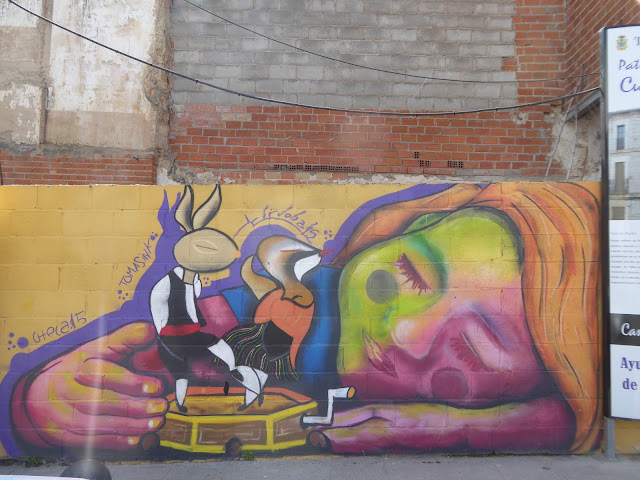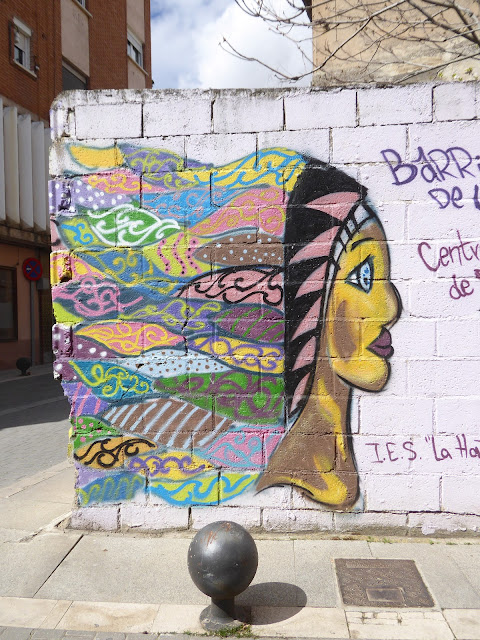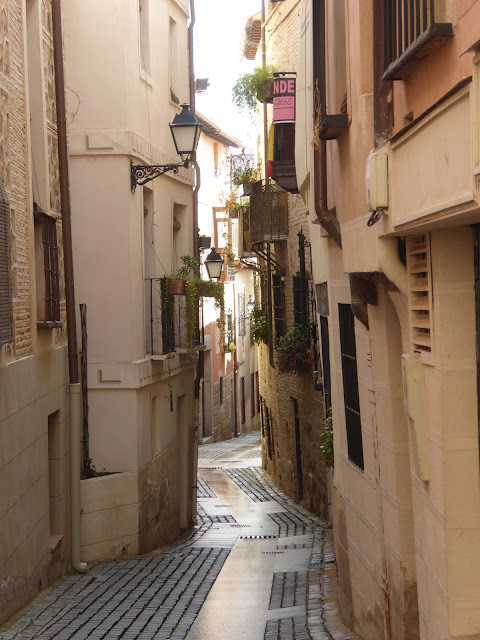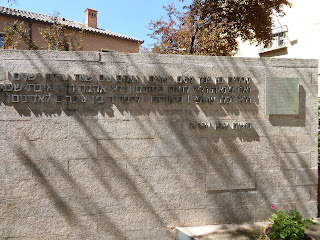TARANCÓN
On the "northern" auto route from Valencia to Toledo is the city of Tarancon. This surprisingly bustling small country town is a municipality located in the province of Cuenca, in the Comunidad Castile-La Mancha.(the autonomous community of Castile-La Mancha, the Spanish version of a state). The municipality has a population of 14,500 inhabitants. "As you drive (towards the city), you get a strong feel for one of Spain's major geographical features, the central meseta, or plateau." The city itself has an urbane feel and obvious rich history that belies its small stature.
IGLESIA
DE NUESTRA SEÑORA DE LA ASUNCIÓN
(Church of the Lady of the Assumption)
15th Century with several renovations and restorations
PLAZA AYUNTAMIENTO
(City Hall Plaza)
Mercat (Market)
Ayuntamiento (City Hall)
AUDITORIO MUNICIPAL Y
MUSEO DE ARTE CONTEMPORÁNEO DE TARANCÓN
(Municipal Auditorium and Museum of Contemporary Art)
The newly restored, CASA DE LA PIEDRA (House of Stone),
now an arts center for the city
TOLEDO
The city of Toledo is the capital of both the Toledo provincia (province) and the Comunidad Castile-La Mancha. The city is situated on promontory overlooking the Tagus River, 42 miles (67 km.) south of Madrid. It was declared a World Heritage Site by UNESCO in 1986:
Successively a Roman municipium, the capital of the Visigothic Kingdom, a fortress of the Emirate of Cordoba, an outpost of the Christina kingdoms fighting the Moors and, in the 16th century, the temporary seat of supreme power under Charles V (the Holy Roman Empire), Toledo is the repository of more than 2000 years of history. Its masterpieces are the product of heterogeneous civilizations in an environment where the existence of three major religions - Judaism, Christianity and Islam - was a major factor.
More importantly, at the end of the 11th century, the Vatican recognized Toledo as a seat of the Church of Spain. In the centuries that followed the city was one of the primary residences of choice for the Castilian monarchy. The monarchy aligned itself with the archbishop of Toledo, insuring that Toledo became a place of considerable power, if not the center of Spain.
The city's population is approximately 83,500 and of these only something like 10,000 actually live in the historic center. What is important to remember is that in 2016, Spain was the third most visited country in the world, recording 75.3 million tourists.
All of them visit Toledo.
STREET SCENES
IIIIIIIIIIIIIIIIIIIIIIIIII
TROMPE L'OEIL (French)
TRAMPANTOJO (Spanish)
("To trick the eye.")
Faux Stone Painted Buildings
IIIIIIIIIIIIIIIIIIIIIIIIII
TEATRO DE ROJAS
CONVENTO DE LA MADRE DE DIOS
A Dominican convent founded in the late 15th century. It was a cloistered monastery, a Guardia Civil barracks and finally a university campus after its acquisition by the University of Castilla-La Mancha to expand the facilities of the Faculty of Judicial and Social Sciences. The academic complex is formed by the Convent of Madre de Dios and of San Pedro Martir.
ALCÁZAR DE TOLEDO
Once used as a Roman palace in the 3rd century, the Alcazar (fortress) that dominates the city was restored by the Holy Roman Emperor Charles V and his son, Phillip II of Spain. The reconstruction began about 1531 and continued into the 1540s to a design by Alonso de Covarrubias, with a courtyard by Francisco Villalpando. Today, it houses the Museo del Ejercito (the Army Museum). Its defense by the Nationalists in 1936 was one of the most heroic episodes of the Spanish Civil War."
Monument to the two-month siege of 1936,
Roman ruins exposed in the new entry pavilion.

View across the river from the Alcazar.
View at the base of the Alcazar.
MUSEO DE SANTA CRUZ
- Also known as -
HOSPITAL DE SANTA CRUZ
(Officially: Provincial Museum of Archaeology and Fine Arts)
Enrique de Egas
Late 15th Century - Early 16th Century
Originally, this was an important "hospital" in the archaic meaning of the word: an institution supported by charity or taxes for the care of the needy. In this instance,the hospital was founded by Cardinal Mendoza to centralize assistance to orphaned and abandoned children in the city. It was converted into a museum in the 19th century. The docents claim that it was once a working hospital - in the modern sense of the word - although I have been unable to find any corroborating information to that effect.
(Photo by others from the Museum website.)
A temporary exhibit of photography of women artists.
LA GRANJA ESCALATORS AND CAR PARK
Jose Antonio Martinez Lapena and Elias Torres Architects, Toledo
2001
2001
(Photo by others.)
A series of six differently angled escalators connecting an underground garage
into and through the ancient walls of the city to the old town center. In peak seasons, the elevators service 40,000 people a day.
The upper "station."
HOTEL CARLOS V ROOF DECK
The Hotel Carlos V is located near the center and almost at the top of Toledo. As a result, the roof-top deck of the hotel affords picture postcard views of the city in all directions, particularly on a day like this.

The hotel dining room is an homage to Mudejar architecture, of which there are numerous examples throughout this post. This is "a style of medieval Iberian architecture and decoration strongly influenced by Moorish taste and workmanship, built by the Muslims of Al-Anadalus who remained in Iberia after the Christian Reconquista, but who were not converted to Christianity." The fact that this is particular iteration is all manufactured in fiberglass or some similar material is...well, part of the overall charm of Toledo.

ESCUELA DE ARTE "TOLEDO"
(Toledo School of Art)

Across from the schooI is a new plaza. I could not understand why it was surfaced with wood slats. On a subsequent visit, the reason was clear, although I was left with several questions.
The fountain never gained more height or breadth so it seems that the drainage system could technically have been much smaller, although it might not have been as "clean" a design. Also, I wonder how long the slats will survive the constant watering.
Note also, the flowers on the steps. These are for sale by an enterprising vendor. Unfortunately, the merchandise also severely restricts the seating capacity (see below: the flowers are more comfortable than the people...).
Regardless, the city should take note of how wonderful the greenery and color makes the space and find a more permanent and non-intrusive way to enliven the area. It does not take an architect to notice that the plaza - even with the geometry of the slats and the few scattered trees - looks rather forlorn when empty.
LA SANTA IGLESIA CATEDRAL PRIMADA DE TOLEDO
(The Primate Cathedral of Saint Mary of Toledo)
LA SANTA IGLESIA CATEDRAL PRIMADA DE TOLEDO
(The Primate Cathedral of Saint Mary of Toledo)
The Cathedral, one of three 13th-century High Gothic cathedrals in Spain is, in the experts' opinion, the best of the lot. It was begun by King Ferdinand III and Archbishop Rodrigo Jimenez de Rada in 1226. The last Gothic contributions were made in the late 15th century when the vaults of the central nave were finished during the time of the Catholic monarchs. It was built atop and completely covers the former city mosque and its cloister covers the former sahn (courtyard in Islamic architecture).
"The spectacular incorporation of light and the structural achievements of the ambulatory vaults are some of it more remarkable aspects." "Outstanding among innumerable works of art are the choir stalls, the large retablo mayor (raised altarpiece), the ornate chapel of Don Alvaro de Luna, the Mozarab Chapel and the Chapter House." There is also an entire museum wing, famous for its collection of paintings by El Greco, Francisco de Goya, Sir Anthony Van Dyck, Luis de Morales, and others. It is built with white limestone from the quarries of Olihuelas, near Toledo.
It is popularly known as Dives Toletana (meaning The Rich Toledan in Latin.)
It is probably the most ostentatious religious structure I have ever had the (dubious) pleasure of visiting...and I have visited hundreds. What it has to do with religion is anyone's guess. What it has to do with the historic glory and power - and, of course, wealth - of the Roman Catholic church is abundantly clear. I have to admit that I was not even particularly interested in buying into the story and photographing it.
During the entire visit I was perplexed as to what the throngs of tourists were absorbing from their tours. Are people still in awe of the Church (capitalized)? What part of their lives does this place feed? Who profits, aside from academics, by the overall gaudy display of it all? Does it, can it, function as a church anymore?
Cuenca had it right: accept that the structure is, in essence, a historical monument and ready-built museum and capitalize on the innate history of the place in a way that attempts to feed the mind into the next century. I saw nothing here to suggest that this was on anyone's agenda.
The backrest of the choir stalls.
Sinagogas (Synagogues)
SANTA MARIA LA BLANCA (12th Century)
EL TRANSITO (14th Century)
(Once known as the "Sinagoga Samuel ha-Levi,"
today it also houses the Sephardic Museum )
SANTA MARIA LA BLANCA (12th Century)
EL TRANSITO (14th Century)
(Once known as the "Sinagoga Samuel ha-Levi,"
today it also houses the Sephardic Museum )
Historical note:
The Alhambra Decree (also known as the Edict of Expulsion) was an edict issued on 31 March 1492, by the joint Catholic Monarchs of Spain (Isabella I of Castile and Ferdinand II of Aragon) ordering the expulsion of practicing Jews from the Kingdoms of Castile and Aragon and its territories and possessions by 31 July of that year.The primary purpose was to eliminate their influence on Spain's large converso population and ensure they did not revert to Judaism. Over half of Spain's Jews had converted as a result of the religious persecution and pogroms which occurred in 1391, and as such were not subject to the Decree or to expulsion. A further number of those remaining chose to avoid expulsion as a result of the edict. As a result of the Alhambra decree and persecution in prior years, over 200,000 Jews converted to Catholicism and between 40,000 and 100,000 were expelled, an indeterminate number returning to Spain in the years following the expulsion. (Wikipedia)
The edict essentially and for all intents and purposes, wiped out Judaism in Spain forever. The number of Jews in Spain today is at best, perhaps 40,000-50,000 out of a population of 46.5 million people, although one statistic places the number as low as 13,000. The edict was formally and symbolically revoked on 16 December 1968
(Photo by others.)
Garden of Rememberance.
(These are old tombs of times past, in which some people rest in eternal peace. Inside there is no hate or jealousy, nor love or hatred of neighbors. When I see them, my mind is not able to distinguish between men or slaves. Moises ibn Ezra.)
"Rabbi Moses ben Jacob ibn Ezra, known as Ha-Sallah was a Jewish-Spanish philosopher, linguist and poet. He was born in Granada about 1055-1060 and died after 1138." Literary critics place him as one of the finest poets of the golden age of Spanish Jewry (900-1200).
LOCUM RESTAURANTE
We discovered this beautiful old restaurant quite by accident on the last night of the visit to Toledo. It is located in a historical, multi-level building, the floors of which all surround a courtyard that is now covered. The reason I am inserting these particular photos here is that at the end of what turned out to be a very special meal, we spoke with the Manager. He repeated several times that this was originally a multi-family Jewish residence. No immediate way to verify this, but it is an interesting story and interesting that the restaurant saw this as important.
AYUNTAMIENTO (City Hall)
Early 18th century
ARCHIVO MUNICPAL DE TOLEDO
(Municipal Archives of Toledo)
Mendaro Corsini arquitectos, 1999
The architects write (for the online architecture guide, www.Architravel.com):
Durante la construcción, fueron muchas las denuncias y las voces que protestaron por la utilización del hormigón en una ciudad patrimonio de la humanidad. Pensamos que el hormigón es intemporal, lo utilizaron los romanos, los árabes y en nuestros días sigue siendo actual.
(During the construction, there were many complaints and voices protesting about the use of concrete in a world heritage city. We think that the concrete is timeless, it was used by the Romans, the Arabs and today it is still current.)
The problem is not the concrete. The problem is the design.
This is actually a modification and extension of the Church of San Marcos which was formerly the church of a convent of the Trinitarios Calzados order that was most recently rebuilt in the 17th century. I have to admit, though, the wall did its job: I did not even realize that there was a church behind it. This perspective view is no longer available because, fortunately, a grove of trees was planted to soften the new plaza.
(Photo by others.)
PARADOR DE TOLEDO
The Parador of Toledo is one of Spain's Paradors Nacional de Turismo. These are primarily abandoned historic structures, including castles, palaces, convents, monasteries, and fortresses converted by the Spanish government into world-class, luxury hotels. The paradors include a few modern structures built in the traditional style in areas of outstanding beauty. The profits from the hotels are earmarked to help fund the conservation of other Spanish monuments.
This Parador was built in 1965 across the river from Toledo for the express purpose of taking advantage of the unsurpassed views from its unrivaled location in the heart of the country house "suburb" of the city dating from the15th century. The photos above that introduce Toledo were all taken from the Parador's terrace. The photos below give a glimpse of what this particular Parador has to offer.
STREET ART

ALCAZAR DE SAN JUAN
Alcazar de San Juan is a town and municipality in the province of Ciudad Real, also part of the autonomous community of Castile-La Mancha, Spain. It is located in the plain of La Mancha, on the "southern" auto route from Valencia to Toledo (or, in this instance on the return trip from Toledo to Valencia). Its name is taken from an old Moorish fortress which was later garrisoned by the Knights of St. John. Its current population is approximately 31,000 people.
Its place in history is, however, the result of its being acknowledged as the birthplace of the 16th and early 17th century Spanish author Miguel de Cervantes Saavedra: Cervantes. Much of the action of Cervantes' Don Quixote takes place near Alcazar. The village of El Toboso (20 miles distant) was the home of the Lady Dulcinea del Toboso, Argamasilla de Alba (26 miles distant) is declared by some to be the birthplace of the original of Don Quixote himself. The famous windmills in the surrounding countryside attest to the literary history of the city and region.
(After reading the above, one of my Spanish tutors told me that I was incorrect: everyone in Spain knows that Cervantes was born in the city of Alcala de Henares, northeast of Madrid about 180 km (111 miles) away. In fact, the King of Spain awards the annual Cervantes literature prize there in a hall that happens to be near the Cervantes Birthplace Museum. After further research, I am happy to report that both towns claim Cervantes as a native son. Alcazar de San Juan bases its claim on a baptismal certificate; Alcala de Henares on, among other things, writings by Cervantes himself. In my mind, the dispute actually makes my visit that much more romantic.)
On a Sunday afternoon, the small town was particularly quiet. We had an excellent meal at a local bar-restaurant that rivaled any menu del dia (menu of the day) that I have had in this country. Without over-stating the case: this town seemed to have an intrinsic whole to it that a tourist mecca like Toledo, however awesome, has now lost forever.
A sign on the side of a non-descript modern building on a small square in the city
announces that Cervantes was born on this site. The event is
announces that Cervantes was born on this site. The event is
memorialized by a small stone obelisk.
In another sign of civic pride and in promotion of cultural identity, the city authorities have installed ceramic placards on significantly-named calles (streets) identifying
the origin and history of the namesake road.
Iglesia Santa Maria la Mayor in the distance.
Torre Don Juan de Austria (Tower of Don Juan of Austria)
14th Century.
Another civic amenity: a concrete bench...and an auto barrier.
IIIIIIIIIIIIIIIIIIIIIIIIIIIIIIIIIIIIIII
IIIIIIIIIIIIIIIIIIIIIIIIIIIIIIIIIIIIIIIIIIII
____________________________________________
Copyright © 2017 Benjamin Clavan













































































































































































